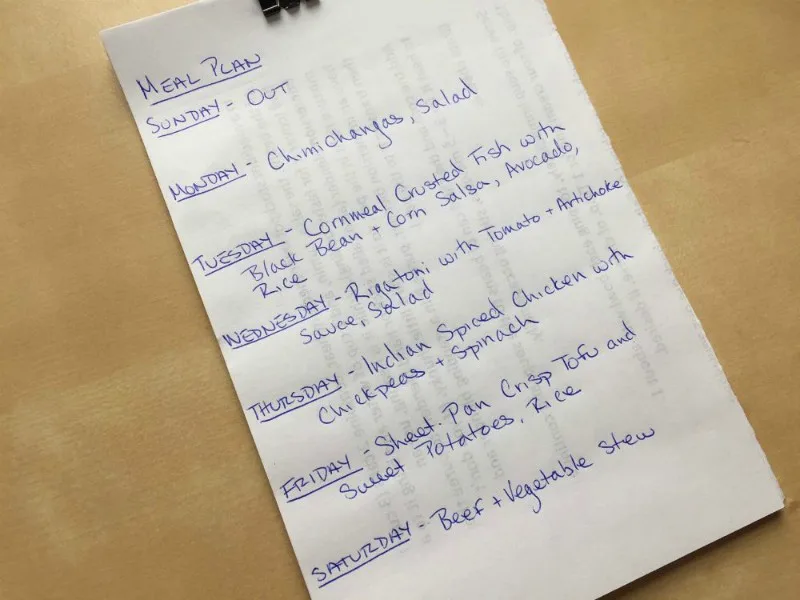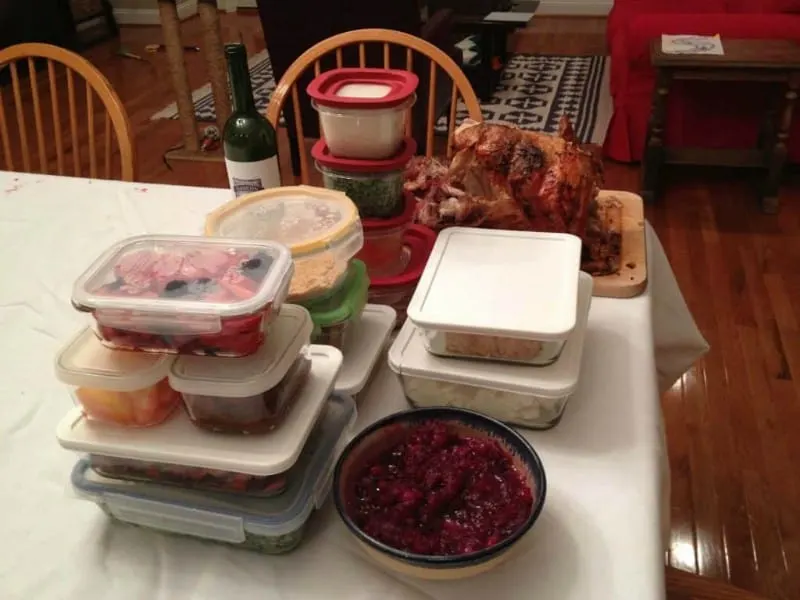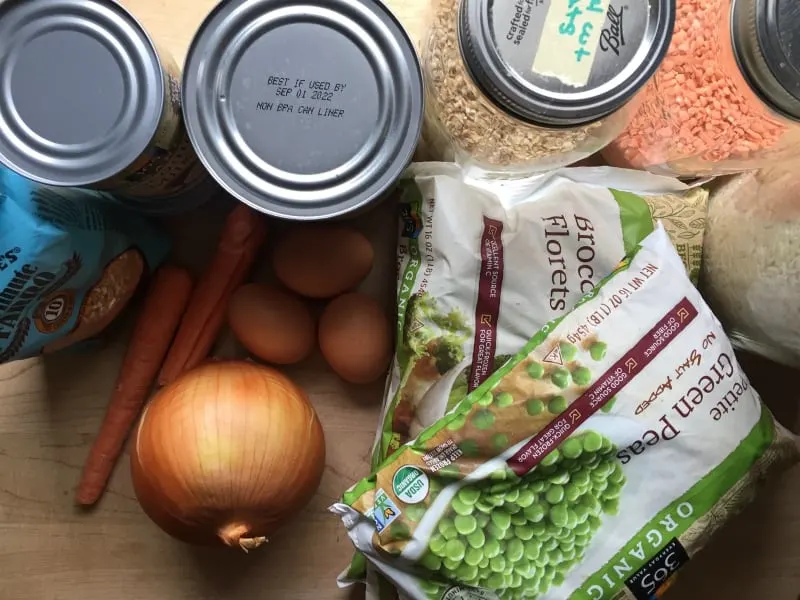There’s no getting around it, feeding a family can get really expensive really fast! But it doesn’t have to be that way! If you want to be able to feed your family but stay on budget, we’ve got you covered! We’ll show you how with a little planning and and thoughtfulness you can feed your family on a tight budget without stress or strain.

How to Feed Your Family on a Budget
Money was pretty tight in my house growing up, especially in early childhood. While we never went hungry, there were times when government support was needed and times when my parents had to depend on credit cards to get us through.
It must have been incredibly stressful and yet, while my brother and I were sometimes aware that the coffers were low, we never experienced food insecurity or even gave a second thought to whether there would be anything to eat for dinner.
The credit for this goes to my mom. Not only would she feed our family of four, but she also somehow always managed to make enough for whoever else might be around. She was a pro at feeding the family on a budget.
Ironically, as a kid I was not interested in cooking, so I wasn’t at her side as she stretched the ingredients we had. And yet, as if through osmosis, I picked up a lot of her tricks for feeding the family on a budget.
I used those tricks as my husband and I were graduate students. And today, even though we are lucky enough not to have the same sorts of financial concerns my parents did, I still seek to keep our family budget in check through careful planning, avoiding food waste, and stretching ingredients as far as I can (especially now that I have two teenage boys who are eating insane quantities of food!).
If feeding the family on a budget is a focus of yours, perhaps these techniques will help you to stay on track, too.

Make a plan
If there is one step to take in order to make feeding the family on a budget possible it’s making a meal plan. Planning out your meals every week does a number of things to help you stay on budget.
- The fact that you are better organized means you minimize impulse purchases and forget fewer items, saving you money, time, and extra trips to the store.
- With a plan in hand, you depend less on restaurants, take out, or more expensive pre-prepared meals.
- When planning carefully, you can use up items that you already have at home, thereby decreasing your grocery bill. Or you can plan out how to use up leftovers, which saves both time and money.
Different Meal Planning Methods
There are a number of ways to plan your meals more easily. Here are some that I have seen work really well for folks.
- Use a meal planning service and for just a few dollars a week the planning and grocery list generation are done for you.
- Assign a day each week when you will plan the upcoming week’s meals (I do my planning on Saturdays). As you plan, make sure to think about your calendar and what evenings you’ll have more time and what evenings you’ll have less time to cook and pick your meals accordingly.
- Set up a rotation of your top 10 or 15 recipes. Then just rotate through these recipes for 2-3 weeks. If you start to get sick of one recipe, find a new recipe and swap it out!
- Suffer from decision paralysis or a lack of ideas? Create a template and fill it in week by week (Meatless Mondays, Taco Tuesdays, Fish Wednesdays, etc.). Having a category to fulfill can make decision-making easier.
- Plan for longer. Sit down once every two weeks or once a month to make your meal plan for a longer stretch. The benefit of this approach is that it allows you to buy more items in bulk, further decreasing your food costs, while also keeping waste to a minimum. (Note: you can do this with The Scramble by customizing your menus.)
One quick tip: No matter which approach you take, make sure to remember to freeze any meat that you won’t be using until later so that it doesn’t go bad.
Check out this post for further tips on meal planning.
Don’t Forget the Other Meals
While planning for dinners is obviously important, having a general idea, or better yet a concrete plan, for the other meals is also key as it reduces the risk of impulse buys or forgetting items. So, before you set off for the store, make sure to think through your grocery needs for breakfasts, lunches, and snacks at least a little bit.

Saving on Groceries
Once your plan is in place, there are a number of ways that you can reduce your costs at the grocery store and feed your family on a budget.
Set a Goal
The first step is to have an amount in mind that you would like to spend each week. To help you determine what your goal should be, the USDA has helpful tables (click on the most recent month’s reports) that outlines what families of different sizes should expect to spend per week and per month.
For a family of four, as of August 2023, for example, the range is from $176.10 per week for the thrifty plan with two small children to $402.80 per week for the liberal plan with two teenage boys.
Then, as you shop, keep a running tally either on your phone or just roughly in your head. As you get close to your spending goal you can make decisions in order to reduce the overall cost.
As you do this more and more, you will start to have a better sense of what you’re spending and what things cost, which can help with further planning and cutting costs.
Shop Sales
The one place where I occasionally go off my list is when I find a good sale on an item that I know we will definitely eat. It could be meat that I can freeze for future weeks, snack foods that are shelf stable, or staples such as grains or frozen vegetables.

Shop in Season
Not only is seasonal produce more flavorful and more likely to be local, but it’s also usually the best deal. So, enjoy those berries while they are at their peak and savor those tomatoes when they are abundant.
Consider a Farm Share
We have been members of a local farm share or CSA (community supported agriculture) for the past 10 years. Year after year, I have compared our weekly produce costs during the winter to what we spend on the farm share and have found that we save at least $10 a week when it is CSA season, which means hundreds of dollars in savings a year!
Avoid Individual Packages
While the convenience of snack packs can’t be denied, you’re also paying a per ounce premium. Instead, consider buying the same item in the larger package and then divvying it up into smaller bags yourself.
Shop Store Brands
Growing up, the generic brand was often considered to be lower quality. This is no longer the case! Give those cheaper, store brands a chance and I bet you’ll be very pleased with what you find and how much you save.
Buy in Bulk (for some things)
Warehouse clubs (like Costco and Sam’s club) can be a great source of savings, but only if you will use all of the food purchased.
Items like meat, fish, cheese, bread, and grains can be well worth the trip, but spices, for example, will likely lose their potency before you get through one of those super-sized containers.
In addition, pay close attention to the per unit cost and take the time to compare it to your regular grocery stores’ unit costs, this way you’ll be sure of the deals you are getting.

Choose Ingredients Wisely
Once planning your meals and shopping more carefully are under your belt, another great way to feed the family on a budget is to choose your recipes based on cheaper main ingredients.
Use Less Meat and Dairy
Meat and dairy are both higher cost proteins, so using them less and opting for cheaper (and healthier) protein sources such as legumes (beans, lentils, chickpeas, green peas, etc.) and tofu helps with feeding the family on a budget.
If giving up meat and dairy is not in the cards for your family, then consider using them more as a flavor enhancer than the main event. For instance, use one or two sausage links in a pasta sauce rather than a full pound, or opt for mixing in some big-flavor feta cheese, rather than serving up a dairy-heavy dish.
Frozen Vegetables Are Your Friends
Frozen vegetables are not only more cost effective, but in most cases they are also just as, if not more, nutritious than the fresh varieties. This is because they are flash frozen within hours of harvesting, so there is no time for them to lose their nutrients.
Frozen vegetables are also helpful when a vegetable you would like to use is not in season, especially in the dead of winter.
Frozen vegetables can, of course, be served steamed, but there is so much more that you can do with them. Use them soups, stews, sauces, stir-fries, and sautés. Some frozen veggies, like broccoli and cauliflower, can even be roasted!

Cook from Scratch
One of the best ways that you can save money on food is to make it yourself.
This starts with preparing your meals and avoiding take out and restaurants (using a meal planning service can make this easier).
If you have the time and inclination, you can save even more money by making some favorites from scratch.
Growing up, this is how my mom saved a bunch of money and also how she could feed a crowd on very little. Another perk: all of these items taste soooo much better when made from scratch. Here are some of my favorites:
Desserts
I make a dessert for my family to enjoy almost weekly. In part I prepare desserts because I use less sugar and can include whole grains, making them healthier options, but I also have found that we prefer the homemade versions.
Need some inspiration? Try our Dark Chocolate Bark or Mango Sherbert with Ginger and Lime.
Breakfast foods
Each Saturday morning I prepare a breakfast in bulk that can be enjoyed that morning and then frozen or refrigerated to be enjoyed for the rest of the week.
Muffins, scones, overnight oats, oatmeal, and egg sandwiches are some of our favorites.
Did you know The Scramble’s weekly meal plan includes a make-ahead breakfast option? This makes it even easier for you to save money and eat healthier!

Snack foods
We all know that kids (and grownups) love their snacks. But snack foods aren’t cheap, nor are they particularly nutrient dense, which is why I like to make at least some of our snack foods from scratch every week. Some of my favorites include homemade popcorn and granola bars.
Stock and Broth
In my freezer you will find Ziploc bags full of vegetable scraps and others with bones. I use these to make my own vegetable and chicken broth.
Once I have a good collection, I’ll plop everything into a stockpot with some bay leaves, thyme, salt, and water, bring it to a boil, turn down to a simmer, and let it cook for at least 2 hours and sometimes all day (stock and broth can also be made in the slow cooker). Once done, I strain the broth, divvy it up into 4 cup portions, and freeze it to use for soups, stews, risottos, and sauces. The flavor is better and I’m saving money—win, win.

Avoid Food Waste
Did you know that Americans waste nearly a pound of food per person per day?!
While some of that is due to waste in restaurants, there are also ways that we waste food at home, such as letting food go bad before using it up and not fully using the ingredients we have.
Here are some ways you can reduce your own food waste and feed the family on a budget.
Shop your pantry
When making your meal plan and grocery list for the week, go through your refrigerator, freezer, and pantry first to see what you’ve got that needs to get used up. Maybe it’s some languishing greens in the produce drawer or some meat in your freezer.
See if you can include that in your meals for the week. You’ll feel virtuous and save some cash at the same time!

Cook in Order of Expiration
As you plan out your meals for the week, a helpful thing to keep in mind is what’s going to go bad faster than other things. Maybe you’ve got some fresh herbs that you want to use before they wilt or some meat that you never got to last week. Move those up in the rotation so that you make good use of them before they need to be tossed.
Leftovers Are Your Friend
I am a huge fan of leftovers, both in their original state or repurposed. In our house we use leftovers as a quick and easy pack-from-home lunch option for my husband, which saves us at least $50/week that would otherwise be spent on buying lunches!
If you aren’t a fan of leftovers, check out these ideas on how to repurpose your leftovers.
As you can see, there are many ways to make feeding the family on a budget easier. From planning, to savvy shopping, to making more from scratch, to reducing food waste, the options abound.
If all of this feels overwhelming, start with one change, get used to it, and then add from there.
Want more ideas for how to feed your family on a budget? Check out our article on feeding teens on a budget, which are tips that can be used universally!
Got other tricks or ideas? I’d love to hear about them in the comments!

Top 10 feeding a family of 5 on a budget That Will Change Your Life - Nhôm kính Nam Phát
Monday 2nd of January 2023
[…] Source: https://www.thescramble.com/cooking-eating-on-a-budget/how-to-feed-your-family-on-a-budget/ […]
How to Feed Teens on a Budget
Thursday 6th of May 2021
[…] How to Feed Your Family in a Budget […]
How to Feed Your Family on a Budget – Healthy Recipe HQ
Sunday 30th of June 2019
[…] and I were sometimes aware that the coffers were low, we never experienced food insecurity … Read More about How to Feed Your Family on a Budget Check out the full recipe here – Read […]